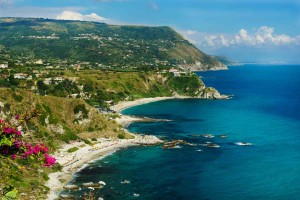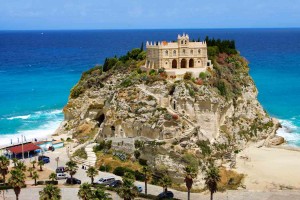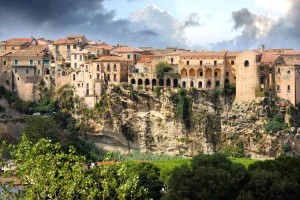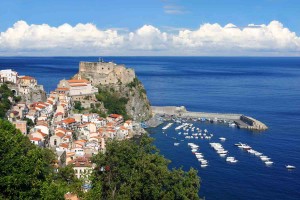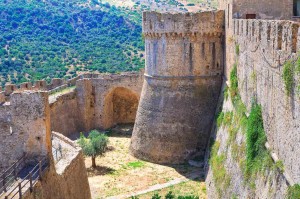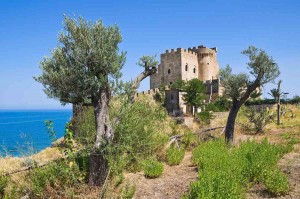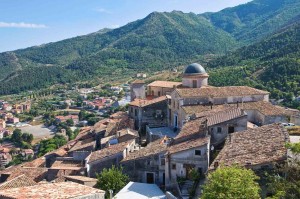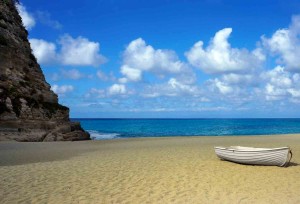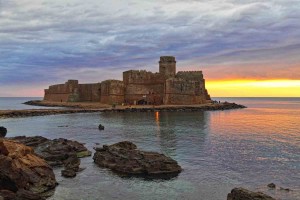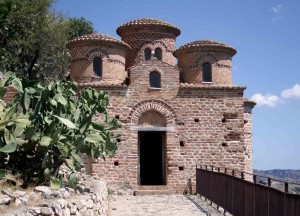One of the sunniest regions in all of Europe can be found in the very south of Italy’s mainland. Guests of Calabria, Italy’s boot tip, look forward to a whopping 320 days of sun. The landmass is characterised by the tripartite Calabrian Mountains, which cover almost the entire area of the region. With the earliest settlements dating back to the Stone Age, fascinating architecture from all eras imaginable can be found throughout the four provinces and the metropolitan capital Reggio Calabria. Find out which marvels of architecture and nature you must see during your next visit with our list of top 10 sights of Calabria.
Capo Vaticano
Don’t let the name fool you: You most certainly won’t meet the boss (Capo) of the Vatican – the Pope, that is – here. The “Cape of Prophecies”, as this place is called in English, borrows its name from an oracle that was visited by seamen back in the days of the old Greeks. There’s still a lighthouse in the closed-off part of the cape in the municipality of Ricaldi. On fair days – and as we know by now, most days in Calabria are breathtakingly beautiful – you have a perfectly clear view of the Strait of Messina and all Aeolian Islands.
Santa Maria dell’Isola in Tropea
The lovely municipality Tropea is located north of Capo Vaticano on the long Calabrian coast of the Mediterranean Sea. Near the town centre a giant rock rises high right in the middle of the beach leading you up to the church Santa Maria dell’Isola. Established in the early Byzantine Middle Ages, it is accessible via steep stairs. The breathtaking view of the town and its surroundings alone is worth the effort. Behind the church there’s a quaint garden with cacti and Mediterranean vegetation waiting for you.
Tropea’s historic town centre
Since you’re already in Tropea, why not tour the picturesque historic town centre? Tropea managed to retain its original charm despite being highly popular with tourists. Stroll blissfully through numerous narrow alleyways surrounded by cafes and boutiques, bars and entertainment. Many small churches and palazzi line your way. Tropea’s cathedral, a fascinating Norman building with a picture of the Virgin Mary of Romania, is nearby. The patron saint is said to have saved the town from a severe earthquake in 1638.
Chianalea di Scilla
Scilla, site of a legendary naval battle in 42 BC, is situated directly at the Strait of Messina. According to legend, the survivors of ancient Troy once settled in the town’s fishing district, Chianalea. To this day the original charm of the district can be felt at every step. A long road leads past colourful boats and dried nets lined by numerous bays and lovingly refurnished houses from days long gone. It hardly comes as a surprise that Chianalea di Scilla was named one of Italy’s most beautiful villages.
The fortress of Rocca Imperiale
Frederick II of the House of Hohenstaufen, initially King of Sicily, later Holy Roman Emperor, spent 29 of his 39 years in power in Italy. During his regency he authorised the construction of numerous castles including the fortress of the 3,000-inhabitant town Rocco Imperiale. Its ruins can be found on a hill high above the closely aligned houses. The “ship”, as the fortress is also called affectionately due to its shape, is constantly being rebuilt granting you fascinating insights into its inner structure.
Castrum Petrae Roseti in Roseto Capo Spulico
Talking about Frederick II, the ruler from the House of Hohenstaufen loved the Castrum Petrae Roseti (Eng. “Castle of Roseto) and had the 10th century Norman castle converted into a fortification. According to legend, the presence of his ghost and that of the previous owners, the Knight Templars, can still be felt. The castle with its three towers thrones on a rock above the Ionic Sea slightly outside the municipality Roseto Capo Spulico. Frederick’s armies used to defend the coast on the very same spot on which you now enjoy the grand view over the water masses. History is palpable at every corner.
Morano Calabro
Once you’re coming close to the small town of Morano Calabro, its charm has already won you over. The picturesque setting on a hill, surrounded by characteristic Mediterranean vegetation, makes you gush and daydream. Houses meander up the entire hill in different levels. The ruins of a Norman castle throne high above them. During an extended town walk you’ll come across many fascinating buildings, such as the charming small church San Bernadino and the agricultural museum. You should also stop by the baroque church Collegiata della Maddalena during your day trip.
Tropea’s beach
Whatever you do, you always seem to return to Tropea. Why, you wonder? Probably because it’s one of the most beautiful places in all of Calabria. Part of it is due to the wide sandy beaches voted among the most beautiful beaches in the entire world by different magazines for good reason. The clean sea has a bluish-green shimmer and borders on a glowing strip of sand framed by the imposing rocks of the town. While Tropea’s fascinating history behind you is waiting to be discovered, you enjoy a sunbath or take a swim in the clear water – a true dream holiday.
Le Castella
Isola di Capo Rizutto is located in the very south of Calabria. Several parts of the town with high seismic activity border directly on the Ionic Sea. During your visit you need to head straight to the district Le Castella, home of most quaint beaches and sights. The Aragonese castle has served as backdrop for many different Italian movies. Expert guides show you how to dive and snorkel in the natural and marine reserve.
Cattolica di Stilo
Currently, efforts are made to have six Byzantine buildings added to the UNESCO list of World Heritage Sites. One of them is the church Cattolica di Stilo on the Monte Consolino in the small town Stilo. Cattolica di Stilo is a Byzantine cross-in-square church, its footprints conforming to a Greek Cross. Mostly unornamented on the outside, the sheer monumental height of the interior room almost overwhelms you. The special arrangement of lights represents the position of man in the ethereal hierarchy.
Calabria’s eventful history can be seen in its very different buildings that form an inspiring symbiosis with the region’s unique nature and topography. Feel the gentle embrace of the centuries and millennia with every step you take. Don’t miss out on Italy’s unique south and click through ZAINOO’s travel suggestions for many more exciting holiday ideas!
